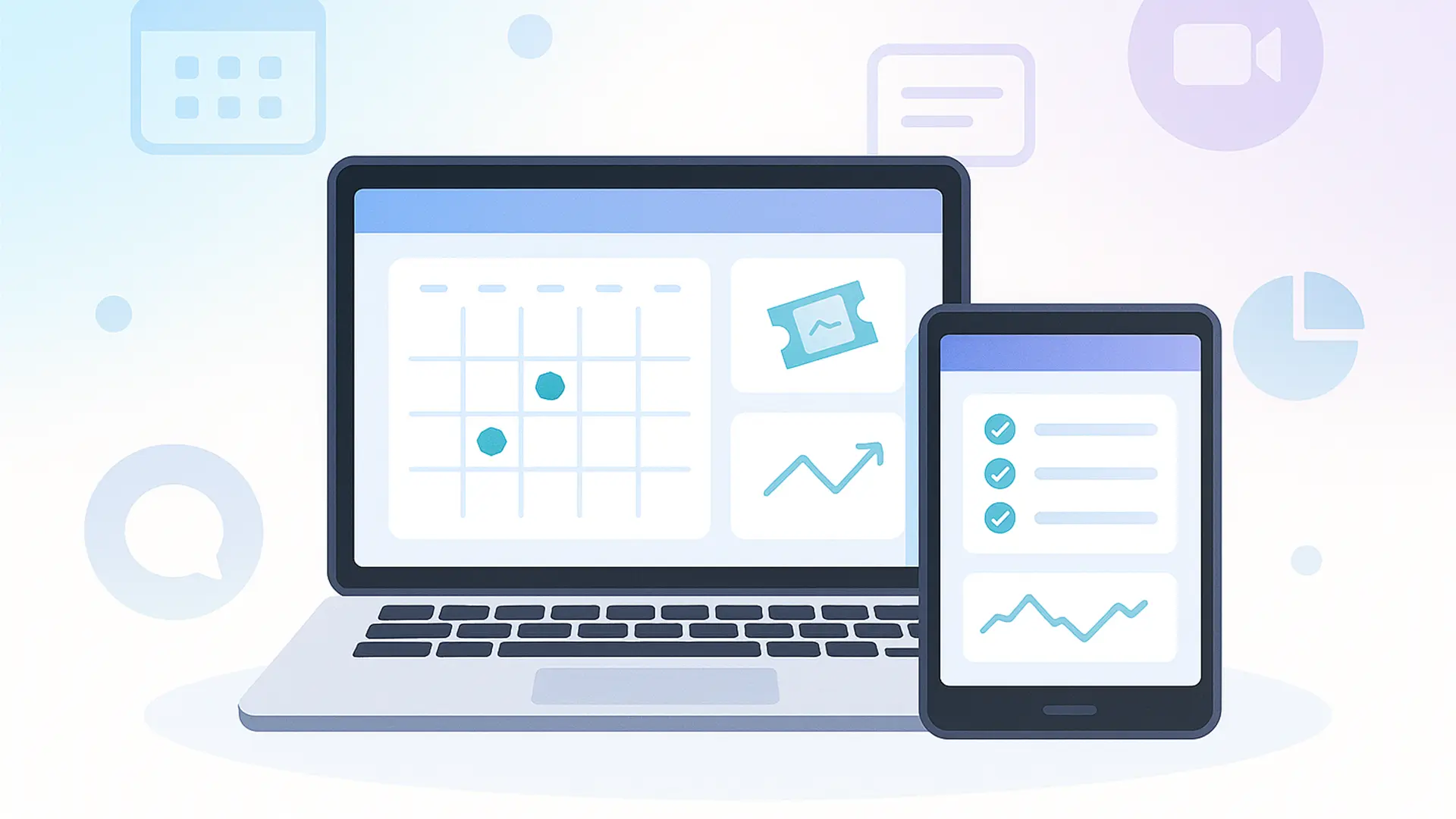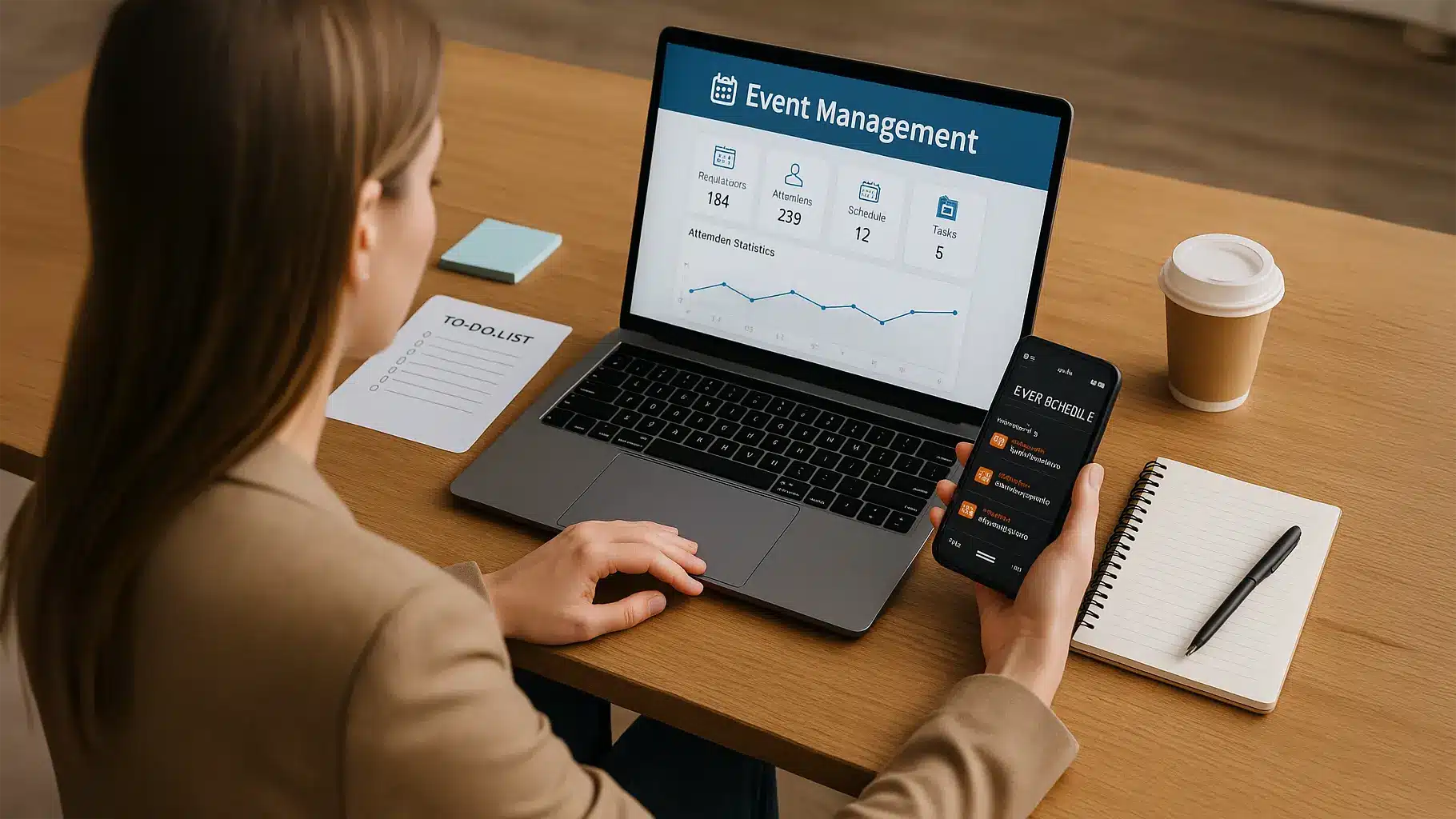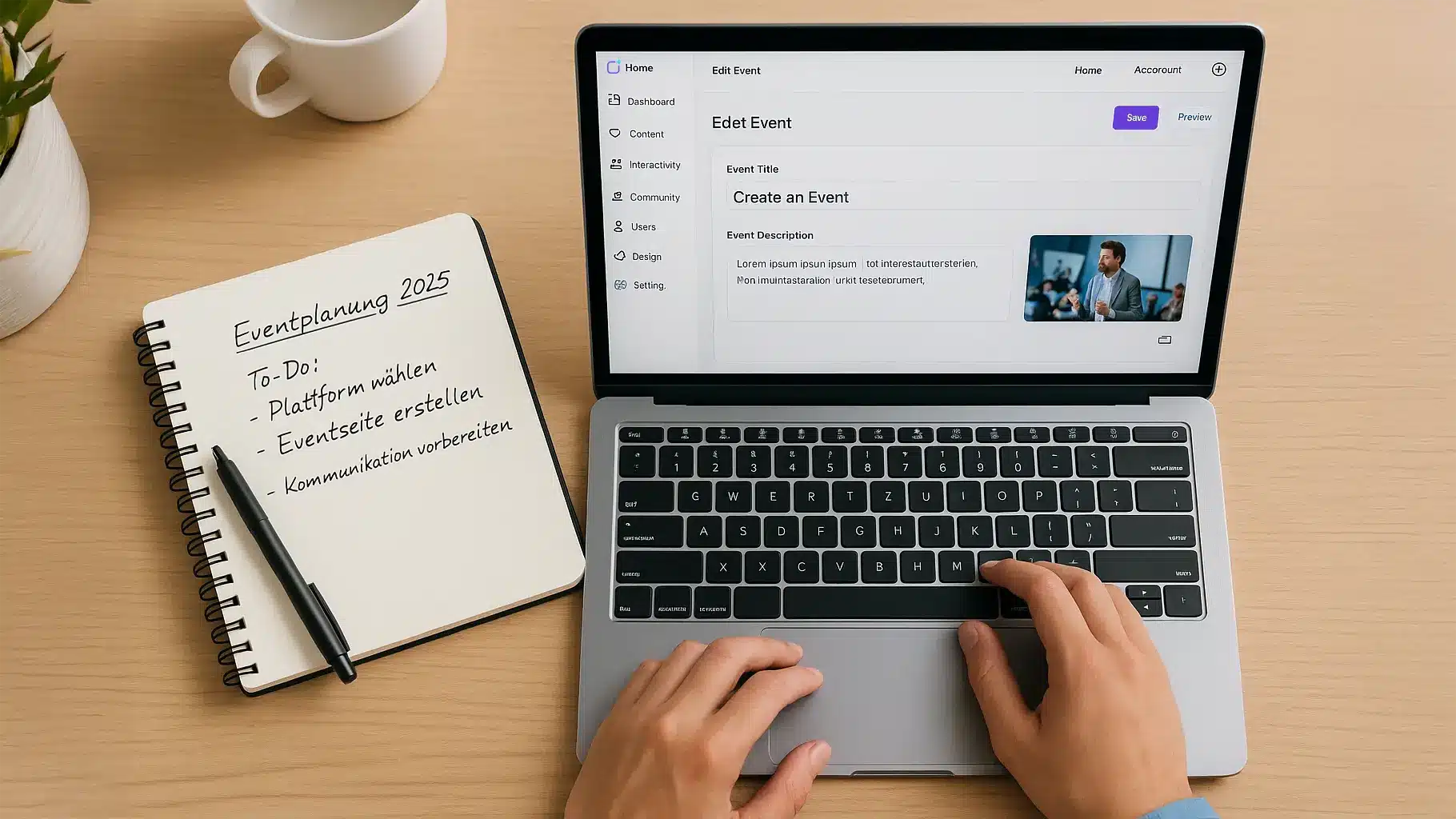If you want to publicise an event, you need more than just an attractive programme: visibility, smooth processes and measurable results are crucial. Today, an event is an experience, a brand and a lead generator all at once – and it only achieves its full effect through visible, well-managed publicity in combination with event management software.
In this guide, we show you step by step how to plan your event, choose the right platform, publish it professionally and then promote it in a targeted manner – so that your event reaches the right target group and performs measurably.
Plan your event strategically
Sound planning lays the foundation for successful publication and efficient management.
Take the time to carefully consider the following aspects:
-
Aim & Purpose
Is brand awareness your main focus, or do you want to generate leads, impart knowledge or create networks? Each goal requires a different strategy and choice of platform.
-
Target Group
Who should participate — customers, experts, partners, employees? Determining the target audience influences not only the content and tone, but also the choice of platform and technology.
-
Format
Will you opt for an online, hybrid or in-person format? Online events enable international reach, while in-person events focus on the local community and experience. Both variants have their own requirements.
-
Date, location, capacity & budget
Clearly define the date, venue (physical or virtual), expected number of participants and budget. These key data will be important later when choosing the platform and software.
-
Roles & Responsibilities
Who is responsible for registration, communication, technology, sponsorship and follow-up? A clear division of tasks avoids duplication of work and misunderstandings.
-
Technical infrastructure & tools
Who is responsible for registration, communication, technology, sponsorship and follow-up? A clear division of tasks avoids duplication of work and misunderstandings.

10 tips for efficient event planning
Efficient event planning: Discover 10 practical tips for successful events – from budget planning and digital tools to participant management.
Platform selection with integrated event management software approach
It’s not just the channel, but the technology behind it that makes the difference. Today, it’s no longer just about registering an event, but choosing a platform that also functions as event management software: from registration and participant interaction to reporting. Polario is an outstanding example of this.
- Central database: registration, participant profiles, feedback, analytics in one system — no isolated solutions.
- More efficient organisation: Instead of connecting lots of tools, you work with one platform that maps many processes (registration, check-in, streaming, analysis).
- Consistent user experience: Your participants navigate through a uniform system – from the registration form to the feedback survey.
- Scalability & reusability: Ideal for organisers with multiple events per year, as processes can be standardised.
- How often do you organise events? For regular events, a comprehensive solution is worthwhile; for one-off events, a simpler platform may be sufficient.
- What formats do you support? In-person, hybrid, virtual – ensure that streaming, networking and interaction are supported.
- Integration & data sovereignty: Can CRM, marketing automation or analytics be connected? Polario offers API & integrations.
- Budget vs. benefits: All-in-one solutions may be more expensive, but they also offer more control options.
- Branding & user experience: Pay attention to customisable environments – your brand should remain recognisable.

Event management software comparison: categories, use, and providers
Which event management software is right for your use case? We show you categories, possible applications, and suitable tools.
Create & manage events: Set up professionally and manage live
It’s not just the channel, but the technology behind it that makes the difference. Today, it’s no longer just about registering an event, but choosing a platform that also functions as event management software: from registration and participant interaction to reporting. Polario is an outstanding example of this.
Title, description and keyword optimisation
The event title should be clear and benefit-oriented. Integrate keywords such as publish event, plan event, promote event, but in a natural and reader-friendly way.
The description should include the following elements: target audience, benefits, agenda, location/format, keynote speakers, conditions of participation. Use subheadings and bullet points to improve readability and SEO.
Visual elements & branding
A high-quality cover image or teaser video attracts attention. Ensure consistent branding (colours, logo, font). Platforms such as Polario allow for individual customisation in the no-code CMS.
A professional impression increases the registration rate.
Registration & Participant Management
Define ticket types (e.g. early bird, VIP, free). Use self-service registration with payments, if necessary. Use tools for participant tracking, check-in via QR code, group registration. Modern systems offer these functions as standard.
During the event, encourage interaction: chats, Q&A, polls (Polario offers these features).
Publication & live support
Publish your event on the platform and, if necessary, on your own website at the same time. Use the platform publication for reach and your website for branding and SEO.
During the event, you can ensure a smooth user experience by keeping the agenda up to date, providing support channels and sending live updates. Tools such as Polario offer real-time dashboards, news feeds and push notifications.

How to manage events efficiently: an overview of methods and tools
Manage events efficiently—with proven tools, clear processes, and a practical step-by-step plan.
Promote your event: Increase reach and registrations in a targeted manner
The best platform and event design are just the beginning – without targeted promotion, the impact will be limited. Make strategic use of various channels:
-
Social Media
Share your event on LinkedIn, Facebook, Instagram, X. Use teaser posts, speaker announcements, behind-the-scenes content and countdown graphics. Link directly to the platform or landing page. Use hashtags. Visuals increase attention.
-
Email marketing
Utilise your existing contact lists. Segment them according to interests, previous participation or customer status. Send an announcement, reminder and last-minute invitation. Message: ‘Register now – limited places available’ or ‘Last chance for early bird tickets’. Link to the platform or ticket page.
-
Content marketing & SEO
Publish blog articles, interviews with speakers, use cases. Link internally to the event page or platform entry. Pay attention to keywords such as ‘publish event’, ‘promote event’, etc. This way, your own website benefits from organic reach – and you drive traffic to the platform.
-
Paid Ads & Partners/Collaborations
Use targeted ads on LinkedIn (for B2B), Meta (for B2C) or Google Ads. Define your target audience and conversion goal (registration) and set up a tracking pixel on the platform page. Collaborations with partners, sponsors or speakers who share your event will expand your reach. Modern software platforms such as Polario offer analytics to measure success.
To make your event marketing even more targeted and creative, it’s worth taking a look at specific strategies and practical ideas. In our article ‘9 ideas for successful event marketing’, you’ll find inspiration on how to optimally combine social media, content marketing, community building and participant engagement to sustainably increase the reach of your event.

9 ideas for successful event marketing
Event marketing thrives on emotions, and with these 9 ideas, you can create events that attract attention, bring in new contacts, and bring your brand to life.
After publication: Measure success & continuously optimise
An event does not end with the last presentation – rather, the evaluation and improvement phase begins afterwards. Utilise the data generated by your platform or software (such as registration, participation, interaction, feedback).
Important KPIs
- Registrations vs. actual attendance
- Registration source (social media, newsletter, platform)
- Engagement metrics (chat posts, Q&A, surveys)
- Conversion rate from visitor to registration
- Cost per participant (for advertising)
- Qualitative feedback from participants
Analysis & Insights
Export the data (Polario offers Analytics & Export, for example) and check: Which sessions were particularly popular? Which marketing channels generated the highest registration ROI? Where were there drop-offs?
Use these insights to better plan your next event: platform selection, format, promotion, content.
Feedback session & follow-up
After the event, send out a survey (online or via the platform). Analyse the feedback – both in terms of content and organisation. Use the results to strengthen your brand as an event organiser.
Also important: transfer participant data to your CRM and incorporate it into future marketing measures.
Platform vs. own website – a strategy with vision
The decision between an external platform and your own website is crucial. But combining both elements cleverly is the best approach.
Advantages of an external platform:
- Fast reach, often integrated user base
- Easy to get started, minimal technical effort required
- Ticketing, registration and management often included
Advantages of having your own website/landing page:
- Full control over branding, texts, SEO
- Leads and participant data remain under your control
- Ideal for long-term brand building and reuse
Combination strategy:
Publish your event both on a platform with event management software (e.g. Polario) and additionally on a separate landing page.
Link both approaches: use the platform to increase your reach and your website to strengthen your brand and SEO. This allows you to combine reach and control.
Conclusion
In the past, ‘publishing an event’ meant entering it into a calendar – today, it is a strategic process: you plan carefully, choose a platform software solution, create professionally, manage live and advertise in a targeted manner.
If you follow these steps consistently, you will not only benefit from the reach of modern platforms, but also manage your event efficiently and measurably — from the initial idea to the evaluation.
FAQ:
What does it mean to publish an event?
Publishing an event means making it publicly available on a suitable platform or website so that potential participants can find it, obtain information about it and register.
Today, this includes not only the simple entry of event data, but also event management functions such as registration, participant communication and evaluation via integrated event management software.
Which platform is best suited for publishing the event?
That depends on your goal and the type of event.
- All-in-one solutions such as Polario, which combine publishing, participant management and communication, are ideal for professional business events.
- For community or leisure events, platforms such as Eventbrite, Meetup or Facebook Events offer good reach.
- Portals such as Eventim are ideal for concerts and shows.
Ideally, you should use a platform that not only makes your event visible, but also controllable.
How can I publish my event for free?
Many platforms offer free basic models, e.g. Eventbrite Free, Meetup or municipal event calendars.
Polario also allows you to create and manage events – with different licence models depending on the range of functions.
Costs usually only arise when tickets are sold or extended management functions are used.
When is the best time to publish an event?
Ideally, publication should take place 6 to 8 weeks before the event date.
For larger conferences or festivals, the period should be even longer – up to 3 months in advance.
This leaves enough time for marketing activities, collaborations, paid ads and early bird tickets.
How can I promote my event most effectively?
Use a mix of organic and paid measures:
- Social media: LinkedIn, Instagram, Facebook for visibility and community building
- Email marketing: targeted invitations, reminders, follow-up campaigns
- Content marketing: blog articles, interviews, event teasers (e.g. 🔗 9 ideas for successful event marketing)
- Paid ads: Google, LinkedIn or Meta Ads for targeted reach
- Event management software such as Polario supports this with integrated analytics tools and communication functions.
How do I keep track of my participants after publication?
Use a central event management platform that consolidates participant data, ticket status, check-ins and interactions.
Systems such as Polario allow all processes – from registration to follow-up communication – to be managed in a single dashboard.
This saves you time and reduces manual steps.
Can I publish my event on multiple platforms simultaneously?
Yes, it is even recommended.
By publishing your event in multiple places (e.g. on your website, Eventbrite and LinkedIn), you can reach different target groups and increase your reach.
Ensure that the information is consistent (date, title, location) to avoid confusion.
How do I measure the success of my event publication?
After the event, analyse key figures such as:
- Number of registrations and participants
- Reach of your posts and advertisements
- Conversion rate from visit to registration
- Feedback and satisfaction of participants
- Tools such as Polario Analytics provide this data automatically – ideal for data-driven event optimisation.
What are common mistakes when publishing an event?
- Late publication → limited reach
- Lack of SEO optimisation of the event page
- Incomplete information (no agenda, no CTA)
- No consistent branding across platforms
- No follow-up communication after the event
Avoid these common pitfalls to ensure your event communication is a complete success.
What are the advantages of event management software such as Polario?
Polario combines event publication, participant management, communication and evaluation in a single platform.
This eliminates the need for multiple tools and gives you a complete overview of your event at all times.
Particularly practical: live communication, feedback tools, CMS integration and analytics are directly integrated – making the entire event journey more efficient and professional.


